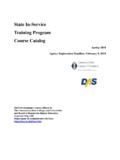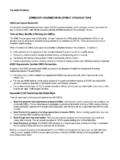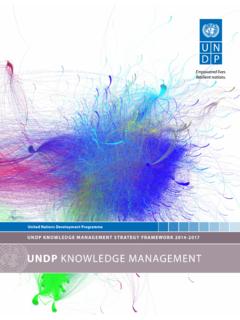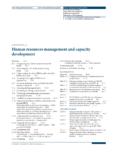Transcription of chapter 52 Designing and implementing training programs
1 chapter 52 Designing and implementing training programsSummary Objectives of training Developing a comprehensive training program needs and knowledge assessments Selecting subject areas and setting learning objectives Learning implementing a training program Assistance for the design and implementation of training courses training and presentation skills Monitoring and evaluationReferences and further readings guide 52-1 Capacity-building framework 52-2 The training process for improved performance 52-3 Seating arrangements for various training applications 52-1 Subject areas, training topics, and target groups 52-2 Comparison of training methods 52-3 Issues to consider when Designing training programs 52-1 Brainstorming.
2 A versatile technique for training , planning, and problem solving 52-2 Outline of trainers and participants guides for workshops studiesCS 52-1 Follow-up activities to support a drug and therapeutics committee course for professionals in developing countries 52-2 Using the MTP methodology in Lao 52-3 Creating a pharmaceutical management training network in East Africa 52-4 Measuring the effect of training on pharmaceutical supply management at primary health care clinics in South Africa 52-1 Sources of assistance for training programs to improve pharmaceutical management 52-2 Workshop logistics management sciences for health 2012 Part I: Policy and economic issuesPart II: Pharmaceutical managementPart III: Management support systemsPlanning and administrationOrganization and managementInformation managementHuman resources management51 Human resources management and capacity development52 Designing and implementing training HUMAn RESOURCES MAnAgEMEnTTraining is any planned activity to transfer or modify knowledge, skills, and attitudes through learning experi-ences.
3 Personnel may require training for a variety of rea-sons, including the need to maintain levels of competence and respond to the demands of changing circumstances and new approaches and technologies. training by itself cannot solve structural, organizational, or policy prob-lems within an organization, although supportive super-vision and the use of motivational strategies can help sustain performance improvement derived from first step in the design of training involves an assess-ment of training needs. The assessment comprises Observing workers performing normal duties Interviewing workers and others Studying routine reports or performance reviews, along with job descriptions Identifying performance problemsThe second step involves defining the training program s learning objectives.
4 The learning objectives, which are derived from the needs assessment, specify the observable, measurable actions that each learner will be able to demon-strate as a result of participating in the training third step is the creation and implementation of a training program to improve performance, taking into account the experience and educational levels of the per-sonnel and the time and resources available for training . Options range from short courses to long-term place-ments in academic institutions in the country, in the region, or overseas, and non classroom-based interven-tions, such as on-the-job training , coaching, and mentor-ing. All options must be weighed against the immediate operational needs of the program or institution, because facilities may not have enough personnel to operate when staff members go for learning outcomes that must be achieved, along with the training environment, audience characteristics, and the experience of the trainer, all determine the mix of learning methods and media that will achieve maximum effectiveness.
5 Methods and media may include lecture, discussion, case study, role-playing, group exercise, simulation games, brainstorming, and demonstration. If no published training materials including audiovisual aids are available, the trainer must develop of the training program also includes design of the training evaluation, which is carried out during the course as well as at its conclusion. During the course, trainers monitor learner progress and satisfaction to identify where they may need to make adjustments to the training program. At the end of the course, trainers should collect data on how well the learners achieved the course objectives and how satisfied they were with the training experience. Whenever possible, the trainer should follow up with participants after they return to their work situations to assess the impact of training on performance.
6 Data collected during follow-up can help identify the need for additional training or reinforcement of newly acquired skills, as well as inform review and revision of the training some countries, availability of basic training and con-tinuous professional development programs is limited; therefore, many health workers lack access to formal training opportunities and new ideas and approaches that can improve their work performance. Well-designed in-service training programs can help fill this should be put into a context of continuous performance improvement. Changing and improving practices require an environment conducive to work, the appropriate learning resources, and the continuous use of motivational strategies. training should be based on competencies: the abilities required to do work to the standards expected.
7 Therefore, training should result in changes in work behavior that lead to an improved, efficiently functioning pharmaceutical management system. At the same time, training alone is unlikely to change overall supply system performance unless the environment and supervisory systems support change (see chapter 37) and unless individuals are encouraged to maintain changes (see chapter 51).Learning requires active involvement. People prefer to learn in different ways through visual stimuli, verbal interactions, and learning by doing. Therefore, offering a variety of training opportunities and training techniques is usually more effective than using only one approach. training can be formal or informal, academic or applied, guided or self-directed, or provided in public agencies or private alone is often not sufficient to change behav-ior or improve performance.
8 Improved performance, changed attitudes, and new skills acquired during train-ing may need to be complemented by and maintained through continuing education, supportive supervision, and adequate motivational incentives. In many cases, structural changes, such as workspace improvements and increased access to supplies and equipment may be needed to support improved 52 / Designing and implementing training programs Objectives of trainingThe training of personnel in pharmaceutical management has four major objectives 1. Increase knowledge about the special considerations related to pharmaceutical systems2. Improve attitudes about the importance of pharmaceu-tical management, thus improving the environment for change3. Build and strengthen skills in the specific tasks to be completed for efficient functioning of the pharmaceu-tical system4.
9 Improve work behavior, so that people function better at assigned activities and fulfill their potentialThe goal of these objectives is to increase access to quality pharmaceutical products and should address the needs of three levels of per-sonnel, because it takes all three groups to effect sustainable change 1. Policy makers, who are responsible for creating the environment needed for improved pharmaceutical management2. Midlevel managers, who are responsible for planning and supervising activities required in the management and use of medicines3. Line or operations-level personnel, who are respon-sible for carrying out the work of pharmaceutical man-agementA country s national pharmaceutical program alone is not in a position to handle comprehensive training for policy makers and midlevel managers; many of their learn-ing objectives are best handled through general manage-ment training .
10 However, it is still possible and necessary to reorient this group on pharmaceutical policies and issues through information exchange, reports, and seminars. training for operations-level personnel is critical because they often lack the basic knowledge and skills necessary to be effective at their , training alone will not result in significantly improved performance unless it is linked to an enabling institutional environment. This is illustrated by Figure 52-1, which is a conceptual framework for building in-country capacity for pharmaceutical management services. It illus-trates the concept that health structures, systems, and roles, staff and infrastructure, skills, and tools must all be addressed to strengthen a country s ability to effectively pro-vide pharmaceutical Developing a comprehensive training programA training program is composed of a schedule of activi-ties with training goals, learning objectives, subject areas, methods, trainers, trainees, methods of assessment, and locations.
















